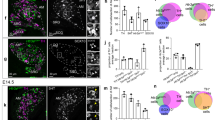Abstract
The intact rat adrenal gland in short-term (3-h) organ culture may be amenable for the identification of factors involved in regulating adrenal cell apoptosis under defined conditions. In this model, culturing in the absence of trophic support (basal; control) triggered apoptosis in the intact rat adrenal gland; oligonucleosome formation, a measure of apoptosis, was 56.4-fold greater than that of glands snap-frozen at the start of incubation. Angiotensin II (Ang II) (100 nM) enhanced apoptosis by 67% over control. By contrast, adreno-corticotropin (ACTH) (100 nM) attenuated basal apoptosis by 59% and antagonized the enhanced apoptosis induced by Ang II back to the control level. Quartering of the glands enhanced basal oligonucleosome formation 182.2% greater than that of intact glands. Interestingly, quartering of the glands abolished the influences of Ang II and ACTH on apoptotic DNA fragmentation, but did not alter ACTH-induced corticosterone secretion. These data suggest that some level of gross adrenal structural information or compartmentalization, sufficiently disrupted by quartering, is required for the hormonal modulation of adrenal cell survival.
Similar content being viewed by others
References
Estivariz, F. E., Lowry, P. J., and Jackson, S. (1992). InThe Adrenal Gland. James, V. H. T. (ed.), Raven, New York, pp. 43–70.
Engeland, W. C., Levay-Young, B. K., Paul, J. A., and Fitzgerald, D. A. (1995).Endocr. Res. 21, 449–454.
Engeland, W. C., Gomez-Sanchez, C. E., Fitzgerald, D. A., Rogers L. M., and Holzwarth, M. A. (1996).Endocr. Res. 22, 395–400.
Holzwarth M. A., Gomez-Sanchez, C. E., and Engeland, W. C. (1996).Endocr. Res. 22, 401–406.
Engeland, W. C., Levay-Young, B. K., Rogers, L. M., and Fitzgerald, D. (1997).Endocrinology 138, 2338–2346.
Zajicek, G., Ariel, I., and Arber, N. (1986).J. Endocrinol. 111, 477–482.
Nussdorfer, G. G. (1986).Int. Rev. Cytol. 98, 1–405.
Mazzocchi, G., Paolo Rossi, G., Rebuffat, P, Malendowicz L. K., Markowska, A., and Nussdorfer, G. G. (1997)Endocrinology 138, 2333–2337.
Mitani, F., Suzuki, H, Hata, J.-I., Ogishima, T., Shimada, H., and Ishimura, Y. (1994).Endocrinology 135, 431–438.
Wyllie, A. H., Kerr, J. F. R., Macaskill, I. A. M., and Currie, A. R., (1973),J. Pathol. 111, 85–94.
Sasano, H., Imatani, A., Shizawa, S., Suzuki, T., and Nagura, H. (1995).Mod. Pathol. 8, 11–17.
Carsia, R. V., Macdonald, G. J., Gibney, J. A., Tilly, K. I., and Tilly, J. L. (1996).Cell Tiss. Res.,283, 247–254.
Wyllie, A. H. (1980).Nature 283, 555–556.
Wyllie, A. H. (1981). In.Cell Death in Biology and Pathology, Bowen, I. D. and Lockshin, R. A. (eds.), Chapman and Hall, New York, pp. 9–34.
Arends, M. J., Morris, R. G., and Wyllie, A. H. (1990).Am. J. Pathol. 136, 593–608.
Schwartzman, R. A. and Cidlowski, J. A. (1993).Endocr. Rev. 14, 133–151.
Tilly, J. L. (1994). InCell Biology: A Laboratory Handbook, Celis, J. E. (ed.) Academic, New York, pp. 330–337.
Yamada, T., Horiuchi, M. and Dzau, V. J. (1996).Proc. Natl. Acad. Sci. USA 93, 156–160.
Balla, T., Baukal, A. J., Eng, S., Catt, K. J. (1991).Mol. Pharmacol. 40, 401–406.
Chiu, A. T., Herblin, W. F., McCall, D. E., Ardecky, R. J., Carini, D. J., Duncia, J. V., et al. (1989).Biochem. Biophys. Res. Commun. 30, 196–203.
Gallo-Payet, N. and Escher, E. (1985).Endocrinology 117, 38–46.
Author information
Authors and Affiliations
Corresponding author
Rights and permissions
About this article
Cite this article
Carsia, R.V., Tilly, K.I. & Tilly, J.L. Hormonal modulation of apoptosis in the rat adrenal gland in vitro is dependent on structural integrity. Endocr 7, 377–381 (1997). https://doi.org/10.1007/BF02801333
Received:
Revised:
Accepted:
Issue Date:
DOI: https://doi.org/10.1007/BF02801333




